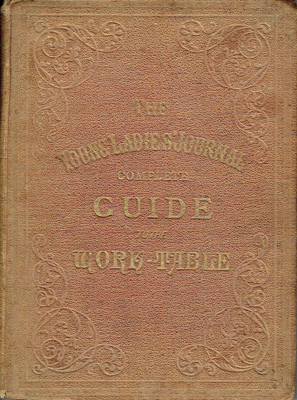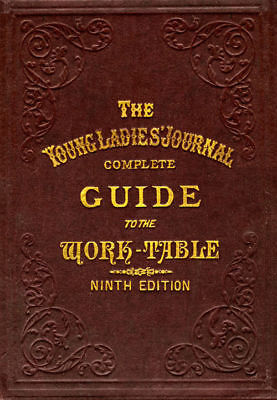
This image was scanned from my private collection

This image was scanned from my private collection
(This is the cover of the lovely Iva Rose Reproduction)
TABLE OF CONTENTS
- BERLIN WORK
- CROCHET
- DRAWN-THREAD WORK, OR POINT COUPE
- EMBROIDERY
- KNITTING
- KNOTTING OR MACRAME
- LACE:
- Limoges
- Old Point
- Point and Honiton
- Venetian Point
- NETTING:
- Fancy Netting
- Guipure Netting
- POONAH PAINTING
- TATTING
Title: The Young Ladies' Journal Complete Guide to the Work-Table
Author/Designer: Not given
Format/Publication Date: HC:1884,COMB:2016
Publisher: E. Harrison, London, UK; Iva Rose Reproductions, East Freetown, Mass.
Language: English
Page Count: 133
Book Dimensions(ht. x w.): 9 1/2" x 6 1/2"
ISBN: None
SUMMARY- The few patterns in the tatting chapter are bland, simple traditional fare, but I found the introduction to the chapter interesting, with a few tidbits worth mentioning. One is that they acknowledged Mademoiselle Riego's contributions to the evolution of tatting, and the second is that they published her instructions for tatting in their Journal in 1864. I'm going to excerpt the Introduction below, because I think it is worth doing so, and I happen to have an original copy of this one, so I'm not plagiarizing Iva Rose's reproduction. There were only eight(8) pages dedicated to tatting, and the introduction was by far the most interesting part of it.
Please forgive me for not typing in the three pages of small print of the Table of Contents - I just gave the main Chapter titles to the left under the cover scans. If you need to know if something more specific is there, just e-mail me. I'll be happy to look it up for you.
INTRODUCTION. There are indications that this pretty and elegant work is likely to be revived in some forms; even were it not so, our "Work-table Guide" would not be complete without full directions for it. The Work Basket deisgn on the cover of this Supplement is one that we have just received as a novelty from Berlin, from which city comes many of our most beautiful fancy-work designs.
The introduction of tatting as fashionable fancy work in England was due to Mademoiselle Riego as far back as 1850. She began to publish books on it, and to her we are indebted for many improvements in the mode of working it. We published her instructions for tatting in our Journal in 1864.
Until tatting was superseded by point lace, about 1870, it was very fashionable and favourite work (and it deserved to be so) as pretty trimmings for dresses or mantles, insertions or trimmings for underlinen, and for cuffs and collars, doilys, cushion-covers, antimacassars, and designs for ornamenting work or paper baskets, etc. can be made in it. Tatting is rather puzzling to learn at first; but when the stitch has once been acquired the work is of the simplest character. It is well suited for drawing-room occupation, as it needs few tools, and it can be taken up and laid down without injury to the work, and one can always tell exactly where one is in a pattern, as it is not mysterious in progress like knitting, nor does one stitch depend in any way upon another. Tatting is strong work; indeed, when once done it is difficult to undo. The old-fashioned mode of tatting, called English tatting, consisted of a series of knots without purls or picots; these were worked with one thread only, the helping thread not having been introduced. The helping thread strengthens the work very considerable, and assists in forming many variations of pattern. The Josephine knot is also a great improvement to many patterns.
Iva Rose Reproductions has a website if you want a good copy of this antique book:
www.ivarose.com